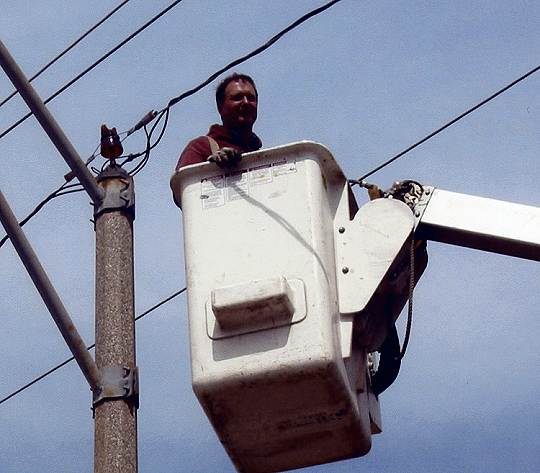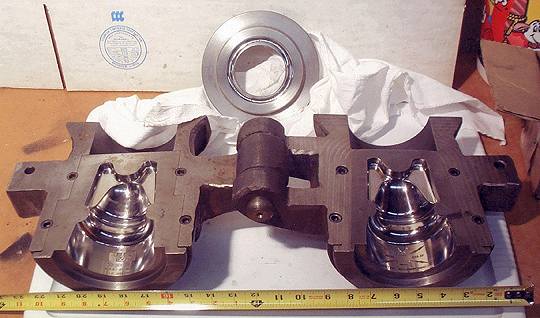H&H Electric Co.
Reprinted from "Crown Jewels of the Wire", June 2003, page 14
Larry Veneziano has created some new commemoratives this year. Shaped like
eared Jumbo's (CD 269), only smaller, these modern collectibles were poured in
ruby red, cobalt blue, and yellow vaseline colored glass.

The one placed in service on the power pole above is a ruby red. Actually,
the H & H Electric Company in Chicago placed a couple on poles. That was
done to prove that the items are completely workable, low voltage insulators and
not just paperweights. Still, the collectibles weren't manufactured to be
insulators, but to commemorate them. H & H intends for its "baby jumbo
insulators to become an icon in the hobby that will be produced in limited
numbers in many colors for years to come."
The insulators are embossed on
the front: (dome) TRIBUTE TO HISTORIC EVOLUTION OF 'ELECTRICITY' (skirt) H&H
ELECTRIC CO / LOCAL #9 IBEW / CHICAGO, ILL. On the back the embossing reads,
(skirt) BABY JUMBO GLASS INSULATOR / COMMEMORATIVE EDITION. Wait, there's still
more embossing. On the base, the insulator reads, L.S. VENEZIANO / COLLECTOR
2002 EDITION. They are dated 2002 because that's when production on the mold
started. But creating a professional mold is time consuming, and the insulators weren't actually poured until this spring. Take a close look at
the high quality of the mold. Note that it is made with the two halves hinged,
in the fashion of historic, original and professional molds created for actual
production runs of glass insulators.

H&H has pledged to keep the
production of these collectibles limited, and to document the numbers produced.
This year, 185 of the baby jumbos were produced in yellow vaseline glass. Those
vaseline colored ones are threadless, and were made for locals and contractors
of the International Brotherhood of Electrical Workers. Only 60 of the vaseline
glass commemoratives became available to insulator collectors.
280 of the
collectibles were made in Ruby Red glass, and are threaded. About half of those
were intended for the I.B.E.W. locals and contractors; with 150 of that number
made available for insulator collectors. 140 more baby jumbos were made in
cobalt blue glass, of which 100 were earmarked for the collecting community.
In
its sales promotions, H&H notes, "From their inception in 1844,
insulators have linked the world. They have lined our railways and our
waterways. Telegraph, telephone, railroad and electrical power service hinged on
the success of the single glass insulator. The insulator itself was manufactured
from many substances including glass, porcelain, metal, and even wood.
"They have been found in various unique shapes and sizes, threaded and
unthreaded. The earliest kind of insulators included, but were hot limited to,
glass knob types, glass blocks that were grooved into crossarms, then pin types
with a smooth threadless pin hole that typically standardized the insulator
industry, until the threaded or screw on concept came along to hold and secure
the insulator to its base.
"This single upgrade changed the configuration
then, and is in use now, as a modern-day insulator. In primitive times,
insulators were usually custom ordered through glasshouses, purchased by power
companies, early telegraph or telephone companies, or private individuals who
engraved their names or logos into the glass to advertise their new and improved
items. Often they strived to improve their insulator by trial and error, each
attempting to make another manufacturers shape and style obsolete. As a result,
over many years, different types, shapes, colors and embossing emerged!
"Over time, interest was created and a hobby was born. People that collect
these insulators consider this hobby a journey through the past. What a tribute
to our electrical history."
Original Jumbo's were made in two styles. CD
269 had a saddle groove at the top to hold heavy electrical cable. The CD 140
had a large wire groove for holding electrical cable on the side of the
insulator. Both styles were typically used in electrically powered subways in
east coast cities.
An advertisement showing the commemoratives in color appeared in the May
issue of Crown Jewels on page 34. Also see this month's ad on page 13. A
percentage of sales goes to union Local No.9 of the I.B.E.W.
| 